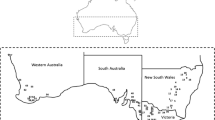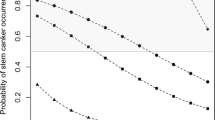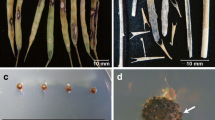Abstract
Blackleg (Phoma stem canker) caused by Leptosphaeria maculans is the most damaging disease of Brassica napus (canola, rapeseed, colza) worldwide and is controlled by sowing blackleg resistant cultivars and crop management strategies that reduce exposure to inoculum and fungicide application. In experiments in south-eastern Australia, canola cultivars inoculated after the three to five leaf growth stage did not develop stem canker. Although mature canola plants are known to be less susceptible to blackleg than seedlings, this highlights for the first time the specific importance of protecting seedlings up to the three to five leaf growth stage in Australia. This would typically correspond to a period of four to six weeks after emergence. Canola plants are likely to be significantly less vulnerable to infection after this growth stage. However, this timing may vary due to the influence of environmental conditions.
Similar content being viewed by others
References
InstitutionalAuthorNameBlackleg Resistance Ratings (2004) Canola Association of Australia
HMA Badawy J Kakau HH Hoppe (1992) ArticleTitleTemperature and ageing of host tissue affect the interactions between different oilseed rape cultivars and pathotype groups of Leptosphaeria maculans Journal of Phytopathology 134 255–263
KE Hammond BG Lewis (1986) ArticleTitleThe timing and sequence of events leading to stem canker disease in populations of Brassica napus var. oleifera in the field Plant Pathology 35 551–564
FR Harper B Berkenkamp (1975) ArticleTitleRevised growth-stage key for Brassica campestris and B. napus Canadian Journal of Plant Science 55 657–658
BJ Howlett (2004) ArticleTitleCurrent knowledge of the Brassica napus–Leptosphaeria maculans interaction Canadian Journal of Plant Pathology 24 245–252
RK Khangura MJ Barbetti (2002) ArticleTitleEfficacy of Impact® to manage blackleg (Leptosphaeria maculans) in canola Australian Journal of Experimental Agriculture 53 311–321 Occurrence Handle1:CAS:528:DC%2BD38XisFOltb4%3D
SJ Marcroft SJ Sprague SJ Pymer PA Salisbury BJ Howlett (2004) ArticleTitleCrop Isolation, not extended rotation length, reduces blackleg (leptosphaeria maculans) severity of canola (brassica napus) in south-eastern Australia Australian Journal of Experimental Agriculture 44 601–606
DC McGee (1977) ArticleTitleBlackleg (Leptosphaeria maculans (Desm.) Ces. & de Not.) of rapeseed in Victoria: sources of infection and relationships between inoculum, environmental factors and disease severity Australian Journal of Agricultural Research 28 53–62
B Poisson A Pérès (1999) Study of rapeseed susceptibility to primary contamination of Leptosphaeria maculans in relation to plant vegetative stage. Proceedings of the 10th International Rapeseed Congress, 1999 Canberra, Australia
T Rouxel A Penaud X Pinochet H Brun R Delourme J Schmit M Balesdent (2003) ArticleTitleA ten-year survey of evolution of races of Leptosphaeria maculans in France indicates a rapid adoption towards the Rlm1 resistance gene of oilseed rape European Journal of Plant Pathology 109 871–881 Occurrence Handle1:CAS:528:DC%2BD3sXotV2jsbg%3D
MU Salam RK Khangura AJ Diggle MJ Barbetti (2003) ArticleTitleBlackleg sporacle: a model for predicting onset of pseudothecia maturity and seasonal ascospore showers in relation to blackleg of canola Phytopathology 93 1073–1081
MR Sosnowski ES Scott MD Ramsey (2001) ArticleTitlePathogenic variation of South Australian isolates of Leptosphaeria maculans and interactions with cultivars of canola (Brassica napus) Australasian Plant Pathology 30 45–51
MR Sosnowski ES Scott MD Ramsey (2004) ArticleTitleInfection of Australian canola cultivars (Brassica napus) by Leptosphaeria maculans is influenced by cultivar and environmental conditions Australasian Plant Pathology 33 401–411
Author information
Authors and Affiliations
Corresponding author
Rights and permissions
About this article
Cite this article
Marcroft, S., Sosnowski, M., Scott, E. et al. Brassica napus plants infected by Leptosphaeria maculans after the third to fifth leaf growth stage in south-eastern Australia do not develop blackleg stem canker. Eur J Plant Pathol 112, 289–292 (2005). https://doi.org/10.1007/s10658-005-1050-1
Accepted:
Issue Date:
DOI: https://doi.org/10.1007/s10658-005-1050-1




